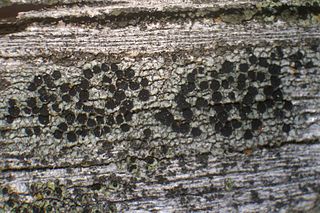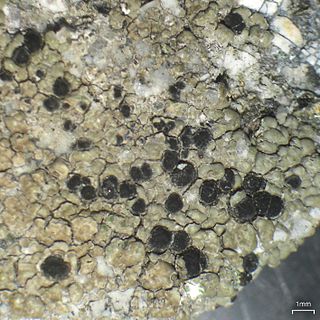
A lichen is a composite organism that arises from algae or cyanobacteria living among filaments of multiple fungi species in a mutualistic relationship. Lichens have properties different from those of their component organisms. They come in many colors, sizes, and forms and are sometimes plant-like, but are not plants. They may have tiny, leafless branches (fruticose); flat leaf-like structures (foliose); grow crust-like, adhering tightly to a surface (substrate) like a thick coat of paint (crustose); have a powder-like appearance (leprose); or other growth forms.

Erik Acharius was a Swedish botanist who pioneered the taxonomy of lichens and is known as the "father of lichenology." Acharius was famously the last pupil of Carl Linnaeus.

Usnea is a genus of mostly pale grayish-green fruticose lichens that grow like leafless mini-shrubs or tassels anchored on bark or twigs. The genus is in the family Parmeliaceae. It grows all over the world. Members of the genus are commonly called old man's beard, beard lichen, or beard moss.

The Parmeliaceae is a large and diverse family of Lecanoromycetes. With over 2700 species in 71 genera, it is the largest family of lichen-forming fungi. The most speciose genera in the family are the well-known groups: Xanthoparmelia, Usnea, Parmotrema, and Hypotrachyna.
A terricolous lichen is a lichen that grows on the soil as a substrate. An example is some members of the genus Peltigera.

Basidiolichens are lichenized members of the Basidiomycota, a much smaller group of lichens than the far more common ascolichens in the Ascomycota. In arctic, alpine, and temperate forests, the most common basidiolichens are in the agaric genus Lichenomphalia and the clavarioid genus Multiclavula. Several lichenized genera occur in tropical regions, the most common being the foliose Dictyonema. Previously basidiolichens had been classified in their own subclass, Basidiolichenes. Molecular based phylogeny does not support classification of the genera together.

The Baeomycetales are an order of mostly lichen-forming fungi in the subclass Ostropomycetidae, in the class Lecanoromycetes. It contains 8 families, 33 genera and about 170 species. As a result of molecular phylogenetics research published in the late 2010s, several orders were folded into the Baeomycetales, resulting in a substantial increase in the number of taxa.

The Verrucariaceae are a family of mostly lichenised fungi in the order Verrucariales. The lichen-forming species, which comprise the vast majority of the family, have a wide variety of thallus forms, and include crustose (crust-like), foliose (bushy), and squamulose (scaly) representatives. Several characteristics of the spore-bearing structures, the ascomata, define the family, including their perithecioid form–more or less spherical or flask-shaped, with a single opening and otherwise completely enclosed by a wall. Squamulose members of the Verrucariaceae with simple ascospores, and without algae in the spore-bearing region are known as catapyrenioid lichens; there are more than 80 of these species. The family has several dozen lichenicolous (lichen-dwelling) examples, and a few genera that contain solely lichenicolous members. An unusually diverse variety of photobiont partners have been recorded, mostly green algae, but also brown algae and yellow-green algae.

Caloplaca is a lichen genus comprising a number of distinct species. Members of the genus are commonly called firedot lichen, jewel lichen. gold lichens, "orange lichens", but they are not always orange, as in the case of C. albovariegata. The distribution of this lichen genus is worldwide, extending from Antarctica to the high Arctic. It includes a portion of northern North America and the Russian High Arctic. There are about thirty species of Caloplaca in the flora of the British Isles. An example species in this genus is Caloplaca saxicola, a lichen with worldwide distribution including the Antarctic continent, Europe and northern North America including the northern reaches of the Canadian boreal forests.

Lecanora is a genus of lichen commonly called rim lichens. Lichens in the genus Squamarina are also called rim lichens. Members of the genus have roughly circular fruiting discs (apothecia) with rims that have photosynthetic tissue similar to that of the nonfruiting part of the lichen body (thallus). Other lichens with apothecia having margins made of thallus-like tissue are called lecanorine.

Buellia is a genus of mostly lichen-forming fungi in the family Caliciaceae. The fungi are usually part of a crustose lichen. In this case, the lichen species is given the same name as the fungus. But members may also grow as parasites on lichens (lichenicolous). The algae in the lichen is always a member of the genus Trebouxia.

Parmotrema is a genus of lichen belonging to the family Parmeliaceae. It is a large genus, containing an estimated 300 species, with a centre of diversity in subtropical regions of South America and the Pacific Islands.

Punctelia is a genus of foliose lichens belonging to the large family Parmeliaceae. The genus, which contains about 50 species, was segregated from genus Parmelia in 1982. Characteristics that define Punctelia include the presence of hook-like to thread-like conidia, simple rhizines, and point-like pseudocyphellae. It is this last feature that is alluded to in the vernacular names speckled shield lichens or speckleback lichens.

Xanthoparmelia is a genus of foliose lichen in the family Parmeliaceae. Xanthoparmelia is synonymous with Almbornia, Neofuscelia, Chondropsis, Namakwa, Paraparmelia, and Xanthomaculina. This genus of lichen is commonly found in the United States, as well as Australia, New Zealand and Ecuador.

Lecidea is a genus of crustose lichens with a carbon black ring or outer margin (exciple) around the fruiting body disc (apothecium), usually found growing on (saxicolous) or in (endolithic) rock. Lichens that have such a black exciple are called lecideine, meaning "like Lecidea, even if they are not in this genus. Members of the genus are commonly called disk lichens or tile lichens.

The Caliciaceae are a family of mostly lichen-forming fungi belonging to the class Lecanoromycetes in the division Ascomycota. Although the family has had its classification changed several times throughout its taxonomic history, the use of modern molecular phylogenetic methods have helped to establish its current placement in the order Caliciales. Caliciaceae contains 36 genera and about 600 species. The largest genus is Buellia, with around 300 species; there are more than a dozen genera that contain only a single species.
A corticolous lichen is a lichen that grows on bark. This is contrasted with lignicolous lichen, which grows on wood that has had the bark stripped from it, and saxicolous lichen, which grows on rock.
Peter Wilfred James (1930–2014) was an English botanist and lichenologist. He was a pioneer in the study of lichens as environmental indicators, especially of atmospheric pollution.















